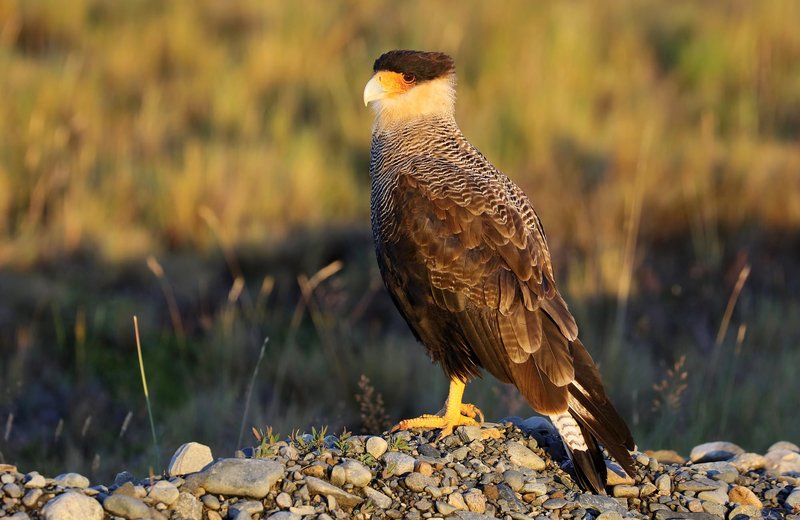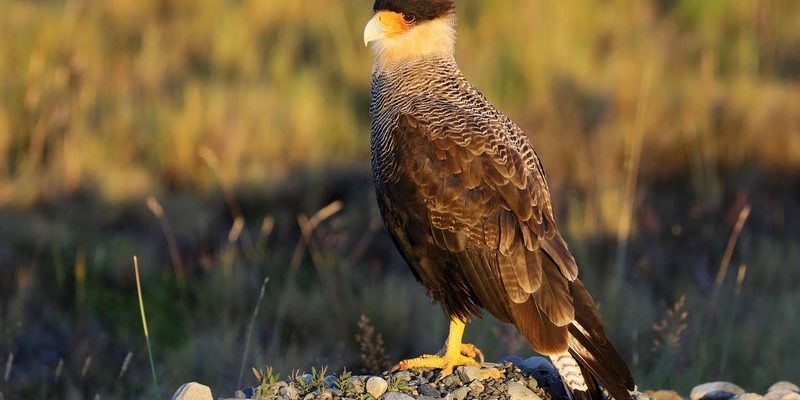
The Crested Caracara is not just another bird of prey; it’s a fascinating mix of beauty and behavior that captures the hearts of birdwatchers and nature enthusiasts alike. Imagine a bird that struts around like it owns the place, with a striking crown of feathers that sets it apart from the crowd. This magnificent creature, often seen in open fields and wetlands, embodies the spirit of the wild, roving through its territory with an air of confidence.
You might find yourself drawn to the Crested Caracara not only for its dramatic appearance but also for its intriguing personality. Unlike many raptors, which tend to be solitary, these birds are social and often found in groups. They have a knack for scavenging, frequently seen joining vultures at carrion sites. It’s an interesting approach to survival, one that showcases their adaptability and intelligence in the wild.
Physical Characteristics
The Crested Caracara stands out in the raptor world for its unique appearance. With a wingspan that can reach up to 4.5 feet, this bird is a sight to behold. The body is predominantly brown with white wing markings, and the most notable feature is its striking crest of feathers on the head. This crest can change in prominence depending on the bird’s mood, serving as a visual signal to others.
In terms of size, males and females are similar, but females tend to be slightly larger. Adult Crested Caracaras can weigh between 2.5 to 4.5 pounds, and their height ranges from 18 to 26 inches. Their powerful beak is designed for tearing flesh, making them efficient hunters and scavengers. The combination of strength and agility allows them to catch a variety of prey, from small mammals to insects.
Here’s a quick overview of their physical characteristics:
| Wingspan | Up to 4.5 feet |
| Weight | 2.5 to 4.5 pounds |
| Height | 18 to 26 inches |
| Coloration | Brown with white wing markings |
Habitat and Distribution
The habitat of the Crested Caracara is as diverse as the bird itself. They thrive in open areas, such as grasslands, savannas, and wetlands. Their range spans across parts of the United States, particularly in Florida, extending down through Central America and into South America. In these environments, they can often be seen perched on fence posts or soaring in the sky, always on the lookout for their next meal.
One of the fascinating aspects of the Crested Caracara is its adaptability to human-altered landscapes. They are frequently spotted in agricultural areas where they take advantage of the plentiful food sources. This ability to coexist with humans makes them a common sight in some regions, though it also poses a challenge for conservation efforts. As we encroach on their habitat, understanding their needs becomes crucial for their survival.
In the wild, these birds often form loose colonies, creating a dynamic social structure. They rely on each other to find food and warn about potential dangers. If you’re lucky enough to observe them, you may notice their intricate interactions and playful behaviors, which add to their charm.
Diet and Feeding Habits
The diet of the Crested Caracara is diverse and reflects its scavenging nature. While they do hunt small mammals and birds, they are perhaps best known for their scavenging skills. You might think of them as the ultimate opportunists, often seen feeding on carrion left by other predators. This role in the ecosystem is vital, as they help clean up the environment by consuming dead animals.
Unlike some raptors, which rely solely on live prey, Crested Caracaras are not picky eaters. Their diet can include roadkill, insects, and even fruits and seeds on occasion. They have been observed using tools, such as dropping hard-shelled nuts or fruits onto hard surfaces to access the nutritious insides. This clever behavior showcases their intelligence and adaptability in hunting and foraging.
When hunting, Crested Caracaras use a combination of sight and strategy. They often patrol their territory from a high vantage point before swooping down to catch their prey. They can be seen chasing after other birds or competing with vultures over a meal. It’s this competitive nature that makes watching them in action so thrilling, as you never know what they might do next.
Behavior and Social Structure
The Crested Caracara is known for its interesting social behavior, which sets it apart from many other raptors. They are typically seen in pairs or small groups, especially outside of the breeding season. This social nature allows them to communicate and collaborate while foraging for food. You might see them engaging in playful antics, such as chasing each other through the air or sharing food at a carcass, showcasing a level of camaraderie rarely seen in birds of prey.
While they are social, Crested Caracaras can also be highly territorial. During the breeding season, these birds become more protective of their nesting sites, which are often placed in trees or on cliffs. The male typically performs elaborate displays to attract a mate, showcasing his strength and agility, making it an impressive sight. The bond between mated pairs is strong, with both parents taking part in raising the young.
You may also notice their unique vocalizations. Crested Caracaras have a range of calls, from sharp screams to whimsical chatter, which they use to communicate with each other and to establish territory. It’s fascinating to listen to them, as each call carries its own meaning and purpose in the social dynamics of these birds.
Breeding and Nesting
The breeding season for Crested Caracaras typically occurs in the spring and can extend into the summer months. During this time, males engage in elaborate courting displays, showcasing their best moves to attract females. This includes aerial displays and vocalizations, which are pivotal in establishing bonds. Once a pair forms, they work together to build a nest, often in trees or on ledges, made up of sticks and vegetation.
Incubation usually lasts around 28 to 35 days, during which both parents share the responsibility of keeping the eggs warm and protected. After hatching, the chicks are quite vulnerable, relying on their parents for food and protection. You’ll find that the parents are attentive, bringing food to the nest and keeping a watchful eye on their young.
As the chicks grow, they begin to explore their surroundings but stay near the nest for safety. They become fledglings after about 60 days, taking their first flights while still relying on their parents for food. This nurturing phase is crucial, as it ensures they develop the necessary skills to survive in the wild once they leave the nest.
Conservation Status
The conservation status of the Crested Caracara varies by region, with some populations facing threats due to habitat loss and environmental changes. While they are classified as a species of Least Concern, localized populations can experience difficulties, particularly in areas where agriculture and urban expansion encroach on their habitats. Understanding these challenges is essential for their continued survival.
Conservation efforts focus on preserving the natural habitats where these birds thrive. Initiatives include creating protected areas and promoting sustainable land use practices that allow for coexistence between humans and wildlife. Education plays a vital role in these efforts, raising awareness about the importance of conserving not just the Crested Caracara but the ecosystems they inhabit.
As a nature enthusiast, you can contribute to conservation by supporting organizations that focus on protecting birds and their habitats. Simple actions, like spreading awareness and participating in local conservation activities, can make a significant difference. After all, every little bit counts when it comes to preserving our beautiful wildlife.
Interesting Facts
The Crested Caracara is full of surprises, and there’s so much more to learn about this amazing bird!
- Unlike many raptors, Crested Caracaras don’t solely rely on keen eyesight; they also use their sense of smell to locate carrion.
- In some cultures, the Crested Caracara is considered a symbol of freedom and resilience, embodying the spirit of the open skies.
- These birds are often found in pairs, and it’s common for them to engage in playful behavior, such as chasing each other or sparring mid-air.
FAQ
What is the habitat of the Crested Caracara?
The Crested Caracara thrives in various habitats, including grasslands, savannas, and wetlands. They are highly adaptable and can often be found in agricultural areas and near human settlements where food is abundant. Their ability to live in different environments contributes to their widespread distribution across the Americas.
How do Crested Caracaras communicate?
Crested Caracaras have a range of vocalizations that they use to communicate with one another. Their calls can vary from sharp screams to softer chirps, depending on the situation. These vocalizations help establish territory, attract mates, and coordinate with their social groups, making it an essential part of their behavior.
What is the lifespan of a Crested Caracara?
In the wild, the lifespan of a Crested Caracara typically ranges from 15 to 20 years, although some individuals may live longer under ideal conditions. Factors such as predation, food availability, and habitat quality all play a significant role in determining their longevity.
Do Crested Caracaras migrate?
Crested Caracaras are generally resident birds, meaning they do not migrate long distances. However, in some regions, they may move locally in search of food or during seasonal changes in habitat. They tend to establish a territory that they defend throughout the year, making them less nomadic than other bird species.
What do Crested Caracaras eat?
The diet of the Crested Caracara is quite varied. They are omnivorous scavengers, primarily feeding on carrion, insects, small mammals, and birds. They are known to be resourceful foragers and can even consume fruits and seeds when necessary, showcasing their adaptability in diverse environments.
Are Crested Caracaras social birds?
Yes, Crested Caracaras are very social birds! Unlike many raptors that prefer solitude, they are often seen in pairs or small groups. Their social nature allows them to communicate effectively while foraging for food and helps them defend against potential threats from other predators.
How can we help conserve Crested Caracaras?
Conserving Crested Caracaras involves supporting organizations focused on habitat preservation and wildlife protection. You can also contribute by spreading awareness about their ecological importance and participating in local conservation efforts. Simple actions, like reducing pesticide use and promoting sustainable land practices, can significantly impact their survival.
Are Crested Caracaras endangered?
The Crested Caracara is currently classified as a species of Least Concern, indicating that they are not at immediate risk of extinction. However, certain populations may face threats from habitat loss and environmental changes. Conservation efforts are essential to ensure the long-term survival of these remarkable birds.
What is the mating behavior of Crested Caracaras?
During the breeding season, Crested Caracaras engage in elaborate courtship displays, showcasing their agility and strength to attract mates. Both males and females participate in nest building and raising their young, demonstrating a strong partnership. Their social behaviors and commitment to their young are key components of their mating rituals.

